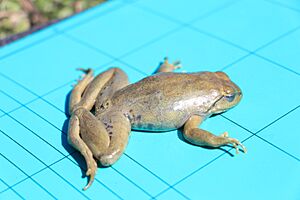Nanorana ercepeae facts for kids
Quick facts for kids Nanorana ercepeae |
|
|---|---|
 |
|
| Paa ercepeae from Lake Rara in Rara National Park, Nepal | |
| Conservation status | |
| Scientific classification | |
| Synonyms | |
|
Rana ercepeae Dubois, 1974 |
The Nanorana ercepeae is a type of frog also known as the torrent paa frog. It belongs to the Dicroglossidae family. This special frog is found only in western Nepal, meaning it is endemic there. It was first discovered in a place called Torrent Jiuli Gad in the Bajhang district.
This frog is quite rare. It usually lives in streams within cool, wet forests found in high-up areas. One of these frogs was even seen in the calm waters of Rara Lake, which is inside Rara National Park. Sadly, the Nanorana ercepeae is facing threats. Its home is being lost or damaged because of small farms growing and people cutting down trees for wood.
Contents
What Does the Torrent Paa Frog Look Like?
Size and Head Features
An adult Nanorana ercepeae frog is about 7.5 centimeters (3 inches) long from its snout to its bottom. Its snout, which is its nose area, is rounded. The frog's head is wider than it is long.
It has a fold of skin above its eardrum, but the eardrum itself is hard to see. The frog's nostrils are closer to its eyes than to the tip of its snout. The area between its eyes and nostrils is slightly curved inwards. Its nostrils are placed on the upper sides of its head.
Eyes and Mouth
The eyes of this frog are quite large. They have a patchy color and pupils shaped like a diamond. The space between its eyes is wider than the width of its upper eyelid. Inside its mouth, the frog has teeth on its palate (the roof of its mouth) and along its upper jaw.
Hands, Feet, and Skin
The tips of the frog's fingers and toes are rounded, like small discs. Its fingers do not have any webbing between them. However, its toes are fully webbed, which helps it swim. The fingers are different lengths, with the shortest being the first finger and the longest being the third.
The frog has clear bumps on its palms and under its finger joints. Its back legs are long and strong, but its thighs are a bit shorter than its lower legs. The toes also have different lengths. The frog has a large bump on the inside of its foot, but the bump on the outside is not very clear.
The skin on the frog's back, head, and sides is completely smooth. It does not have any folds of skin running along its back. The opening where the frog gets rid of waste is quite noticeable.


